IMDEA Networks

Events agenda
25 Jan
2016
Distributed power and rate control in wireless networks
Themistoklis Charalambous, Post-Doctoral Researcher at the Communication Group of the Department of Signals and Systems, Chalmers University of Technology, Gothenburg, SwedenThe standard interference functions introduced by Yates have been very influential on the analysis and design of distributed power control laws. While powerful and versatile, the framework has some drawbacks: the existence of fixed-points has to be established separately, and no guarantees are given on the rate of convergence of the iterates.
Read more arrow_right_alt13 Jan
2016
Human behavior: the interaction governing complex socio-technological systems
Anxo Sánchez, Founder of GISC (Grupo Interdisciplinar de Sistemas Complejos), Professor at the University Carlos III of Madrid, Department of Mathematics & Institute UC3M-BS of Financial Big DataUnderstanding complex physical systems requires knowledge of the interactions among their constituents, in order to be able to predict emergent behaviors (i.e., of the system as a whole).
Read more arrow_right_alt27 Nov
2015
PhD Thesis defense: Enhancement in Spectrum Management Techniques for Heterogeneous 5G Future Networks
Vincenzo Sciancalepore, IMDEA Networks Institute, University Carlos III of MadridIn the last decade, cellular networks are undergoing with a radical change in their basic design foundations. The huge increase in traffic demand requires a novel design of future cellular networks.
Read more arrow_right_alt25 Nov
2015
Measuring the Mixing Time of a Network
Antonio Carzaniga, Università della Svizzera Italiana (USI), SwitzerlandMixing time is a global property of a network that indicates how fast a random walk gains independence from its starting point. Mixing time is an essential parameter for many distributed algorithms, but especially those based on gossip.
Read more arrow_right_alt6 Nov
2015
I IMDEA Conference – Science, Industry & Society
On 6th of November 2015 IMDEA Materials, one of the seven IMDEA Institutes, opened its doors for the 1st IMDEA Conference: Science, Business & Society.
Read more arrow_right_alt4 Nov
2015
Internet of People - An Approach to People-Centric Internet of Things
Prof. Dr. Fernando Boavida, Full Professor, Faculty of Science and Technology, University of Coimbra, PortugalTechnology now offers the possibility of delivering a vast range of low-cost people-centric services to citizens. Internet of Things (IoT) supporting technologies are becoming robust, viable and cheaper.
Read more arrow_right_alt30 Sep
2015
Some Approaches to Wireless Sensor Networks, IoT, and the Internet of People
Fernando Boavida, University of Coimbra,PortugalSeveral challenges persist in what concerns wireless sensor networks, the Internet of Things, and the use of these technologies in human-centric environments.
Read more arrow_right_alt28 Sep
2015
Using SDN/OpenFlow in real life networks
Alexander Shalimov, PhD, Moscow State UniversityProgrammable networks or Software Defined Networking (SDN) offers new opportunities to manage computer networks: Make networks smart, introduce new service faster.
Read more arrow_right_alt25 Sep
2015
Science and movie scientists: Does reality surpass fiction?
How do science and movies get along? Is it true that, most of the times, truth is stranger than fiction?
Read more arrow_right_alt25 Sep
2015
PhD Thesis defense: Enhancing Wireless local area Networks by leveraging Diverse Frequency Resources
Thomas Nitsche, PhD Student, IMDEA Networks Institute & University Carlos III of MadridIn this thesis, signal propagation variations that are experience over the frequency resources of IEEE 802.11 Wireless Local Area Networks (WLANs) are studied.
Read more arrow_right_alt- arrow_back_ios
- 1
- …
- 45
- 46
- 47
- 48
- 49
- …
- 78
- arrow_forward_ios

